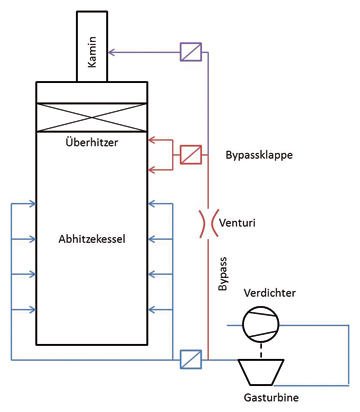Fuel-Air Ratio Control
Optimization of the Lambda Control of a CCGT Unit
 Lambda determination in the boiler of gas and steam power plants (combined cycle power plants) is often carried out in older plants by the separate metrological detection of the fuel quantity and the amount of flue gas supplied to the boiler from the gas turbine. In particular, for the detection of the air flow, it is necessary that the measurement provides reliable results over a wide measuring range. If the measurement deviates strongly from reality, incorrect air control leads to incidents in the combustion, which are noticeable at the burner due to error messages from the flame detectors or at the chimney due to high emission values.
Lambda determination in the boiler of gas and steam power plants (combined cycle power plants) is often carried out in older plants by the separate metrological detection of the fuel quantity and the amount of flue gas supplied to the boiler from the gas turbine. In particular, for the detection of the air flow, it is necessary that the measurement provides reliable results over a wide measuring range. If the measurement deviates strongly from reality, incorrect air control leads to incidents in the combustion, which are noticeable at the burner due to error messages from the flame detectors or at the chimney due to high emission values.
In a combined cycle power plant, the exhaust gas of a gas turbine in the downstream boiler is used as combustion air. In this way, the heat in the exhaust gas can be used to generate steam, which significantly increases the efficiency of the entire system. In order to have an optimal fuel/ air-mixture available both in full load operation and in partial load operation of the boiler, a variable part of the exhaust gas is passed via a bypass past the burners to the superheaters.

For compact power plants, the bypass is well suited for flow measurement because of its length. From the difference of the (relatively constant) amount of flue gas from the gas turbine and the measured (variable) bypass flow rate results the supplied amount of flue gas to the boiler. Ideally, in full-load operation of the boiler, this flow rate is low, while it increases in part-load conditions because less flue gas is required for combustion in the boiler.
The volume control is performed by means of throttle valves and can cover a range of a few m³/s up to more than 300 m³/s for a power plant of the 400 MW class. Especially in the lower measuring range, this poses major challenges for conventional venturi measurements. If the flue gas velocity is too low, the measuring signal in the venturi becomes too weak and -as a result – the volume flow is measured too low.
The control system then calculates an excessively high volume flow to the boiler and thus an excessively high lambda value. If the actual fuel/ air ratio locally falls below a value of lambda = 1, an increase in CO emissions is the result.
The operating team counteracts such events by increasing the desired lambda value, which then often leads to signal disturbances at the flame detector.
heat and power engineering measured the volume flow in the bypass duct at various load points and simulated a characteristic diagram depending on the damper position for different ambient conditions. When added to the control system, the diagram replaces the venturi measurement outside the confidence interval. In the simulation, the effects of an upcoming gas turbine retrofit could also be anticipated.
The re-commissioning after the retrofit with the optimized lambda control took place trouble-free. The CO emissions could be significantly reduced with more stable operation of the power unit.
Deutsch
